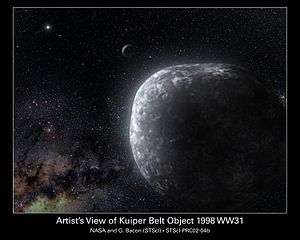S/2000 (1998 WW31) 1
|
Artist's impression of the 1998 WW31 system. S/2000 (1998 WW31) 1 is the dark disk in the distance. | |
| Discovery[1] | |
|---|---|
| Discovered by |
Christian Veillet Alain Doressoundiram |
| Discovery date | December 21, 2000 [2] |
| Designations | |
| none | |
| Orbital characteristics[2] | |
| Epoch January 26, 2002 (JD 2452300.5) | |
| Apoapsis | 40,600±2570 km |
| Periapsis | 4120±1260 km |
| 22,300±800 km | |
| Eccentricity | 0.817±0.05 |
| 574±10 d | |
Average orbital speed | ~0.002 km/s |
| 149.6±19 ° | |
| Inclination | 41.7±7 ° |
| 94.3±8 ° | |
| 159.5±15 ° | |
| Physical characteristics | |
| Dimensions | 110±12 km |
| Mass | 4.9–19.0×1017? kg |
Mean density | 1.5±0.5? g/cm³ (assumed) |
| 0.014–0.034? m/s² | |
| 0.037–0.065? km/s | |
Sidereal rotation period | assumed synchronous |
| assumed zero | |
Pole ecliptic latitude | 48.3±7 ° |
Pole ecliptic longitude | 4.3±8 ° |
| Albedo | 0.06±0.01 |
| Temperature | ~ 43 K |
Spectral type | ? |
| 6.45 | |
|
| |
S/2000 (1998 WW31) 1 is the moon of the trans-Neptunian object 1998 WW31. It was discovered in April 2001 by Christian Veillet and Alain Doressoundiram on images taken December 21, 2000 and December 22, 2000.[2] Other images previously obtained by other observers were used to confirm the binary nature of the object and to help pin down its orbit. This was the first binary Kuiper Belt object (KBO).
References
- ↑ http://cfa-www.harvard.edu/iau/lists/NumberedMPs.html
- 1 2 3 Veillet, C.; Parker, J. W.; Griffin, I. P.; Marsden, B. G.; Doressoundiram, A.; Buie, M. W.; Tholen, D. J.; Connelley, M.; and Holman, M. J.; The binary Kuiper-belt object 1998 WW31, Letters to Nature, Vol. 416, pp. 711–713 (April 18, 2002)
External links
This article is issued from
Wikipedia.
The text is licensed under Creative Commons - Attribution - Sharealike.
Additional terms may apply for the media files.
